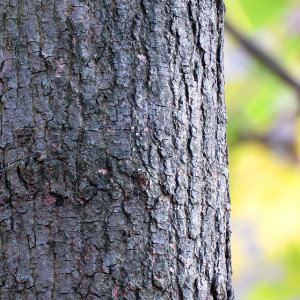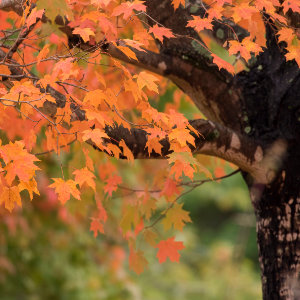Norway Maple
Norway maples are known by many people as popular landscaping trees in commercial and residential spaces. However, the seeds from mature Norway maple trees can invade nearby forested landscapes where they displace and outcompete native vegetation over time. This undesired spread leads to less food sources and degraded habitats for local wildlife and insect populations.
- Katja Schulz, “Norway Maple”, CC BY 2.0
- Credit: mwms1916, “Norway maple, apple tree, fence – 6 Oct 2013”, CC BY-NC-ND 2.0
- Credit: Katja Schulz, “Norway Maple”, CC BY 2.0
Identification
Norway maple is a large deciduous tree that can grow to heights of 40-65 feet. Its crown shape is rounded and the canopy can be very dense. Leaves are dark green in color with smooth edges, each with 5-7 lobes. In the fall, Norway maple leaves turn a pale yellow color. The bark of this tree is gray or brown and fairly smooth. Look for this tree in residential and commercial settings In natural spaces, Norway maple can be found growing in forests adjacent to suburban areas.
Norway maple may be confused with other types of maple trees such as:
- Sugar maple (Acer saccharum)
- Red maple (Acer rubrum)
- Silver maple (Acer saccharinum)
However, Norway maple can easily be distinguished from these other tree types because its leaves and twigs ooze milky white sap when cut or torn.
Norway Maple Field Identification – Credit: Lower Hudson PRISM
Additional information on how to identify Norway maple be found online.
Ecological Threat
Norway maples form monocultures by displacing native trees, shrubs, and herbaceous understory plants in forested landscapes. Once established, it creates a canopy of dense shade that prevents regeneration of native seedlings. Additionally, research has shown that forests invaded by Norway maple have less wildflower diversity compared to forests dominated by native sugar maple (Acer saccharum).
Control and Removal
If Norway maple is present on your property, consider removal and management options. The following resources provide valuable information and tips.
Other management tips can be found at:
Plant Native Alternatives
*This list is not comprehensive, but rather provides a sampling of species available for purchase from retailers located in Pennsylvania and/or surrounding states. All native plant distribution maps (below) are provided by the Biota of North America Program.
- Credit: Jeanne, “Sugar Maple”, CC BY-NC-ND 2.0
Sugar Maple (Acer saccharum)
Sugar maple prefers to grow in average, medium moisture, well-drained soils and in areas that receive full sun to part shade. It can grow to heights of 40-80 feet (sometimes even 100 feet). Consider planting this tree if you have an interest in producing maple syrup.
- Credit: Katja Schulz, “Black Tupelo”, CC BY 2.0
Black Gum (Nyssa sylvatica)
Black gum can be planted in average, medium to wet soils and in areas that receive full sun to part shade. Its preference is to be in areas that are generally moist, and it can even grow in standing water. Interestingly enough, black gum can also tolerate some drought conditions and adapts to growing in dryer soils, at least in the wild. This tree can grow to be 30-50 feet tall.
- Credit: Dan Keck, “Great White Oak of Logan”, Public Domain
White Oak (Nyssa sylvatica)
White oak is an adaptable tree species able to grow in a wide variety of soil conditions, though prefers areas that are well-drained and slightly moist. It has good drought tolerance. This tree species can grow to a height of 50-80 feet.
Learn More and Take Action
Why are Native Plants Important?
Learn more about the importance of planting native plants by reviewing the following resources. And remember, planting even one native plant on your property is a tremendous benefit to wildlife and the environment!
Doug Tallamy Explains, “Why Native Plants?”
Credit: Catherine Zimmerman

Landscaping with Native Plants in Pennsylvania
Credit: PA Department of Conservation and Natural Resources
Professor Doug Tallamy on Sustainable Landscaping
Credit: University of Delaware
Discover Native Plants.
Learn what plants are native to your area by using the National Wildlife Federation’s Native Plant Finder or the Audubon’s Native Plants Database. Both programs are easy to use - just type in your zip code and a list of native plants is provided to you.
Record Invasive Species Findings with iMapInvasives.
If you find invasive plants and animals in natural areas such as parks, forests, and meadows, please report them to iMapInvasives, an online tool used by natural resource professionals and citizen scientists to record locations of invasive species The iMapInvasives program is useful in understanding species distributions statewide and is used by land managers to prioritize locations to conduct treatment efforts. In Pennsylvania, the iMapInvasives program is administered by the Western Pennsylvania Conservancy and the Pennsylvania Natural Heritage Program and is financially supported by the Great Lakes Restoration Initiative. At the national level, iMapInvasives is administered by NatureServe.
A free registered user account is needed in order to contribute and view data in iMapInvasives. Register here.
How to create a presence record in iMapInvasives online (video)
Connect with Our Experts
Please direct any questions or comments regarding this species profile to Amy Jewitt, Invasive Species Coordinator, or Mary Walsh, Aquatic Zoology Coordinator.

















